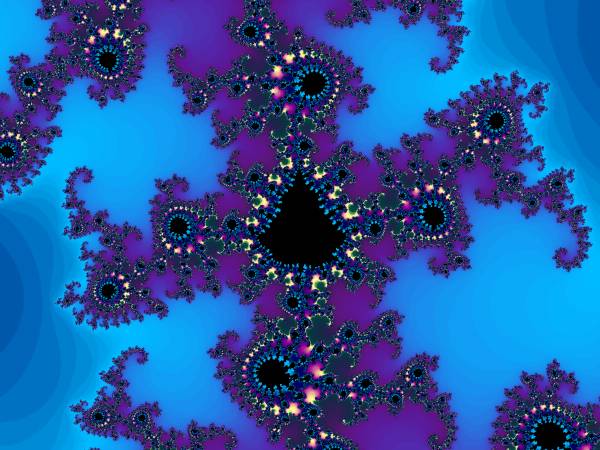From the Simple to the ComplexClick mouse to choose a value of "C" <Alt>Click mouse to Zoom In (either panel) <Ctrl>-Click mouse to Zoom Out. Use the arrow keys to nudge the cursor by one pixel at a time. Sensitivity to Initial Conditions
One thing that we can easily observe is how sensitive this system is. Zoom in a few times to find somewhere interesting, and place the cursor somewhere
very close to the edge of the Mandelbrot Set. Uncheck the "Animate' checkbox. Use the arrow keys to nudge the cursor one pixel at a time, and
you will sometimes see abrupt and radical changes in the orbit diagram in the right panel.
We are comparing the orbits for two very similar values of C, and it is apparent that no matter how close our two starting points may be, the orbits may have radically different outcomes. Indeed, being infinitely complex, we can never zoom in all the way to the edge. We can go arbitrarily deep, and still find that one point may have a finite orbit while a neighboring point infinitesimally close by may have an orbit that goes to infinity. The deeper we go to explore the edge, the more iterations it will take before we can determine the fate of the starting point. This type of behavior that can change abruptly when we nudge the starting value a small amount is an example of Sensitivity to Initial Conditions, a key concept
in Dynamic Systems, the foundation of fractals, and one that we will revisit in Chapter 6, on Chaos.
Iteration Artifacts
Note: If we stop iterating too soon and give up before the point reaches some threshold and spirals outward, we will mistakenly assume this starting point
belongs inside the Set, and so it will be colored black, even though it actually should belong outside the Set. Whatever magnification we're looking at,
if we compute the Mandelbrot Set with a finite number of iterations (as we must) our pictures can only be approximations to the ideal, perfect object. Our
estimate will always be a little bigger than the actual Mandelbrot Set, as there will always be some points that are really outside the Set but that don't
escape before we give up iterating.
This means that the deeper we explore, the more iterations we must compute, and the slower it becomes. (The numbers also gain decimal places and get slower for that reason as well.) No matter how fast our computers ever become, we will always be able to generate fractals that push the limits of what they can do. There is an artistic motivation as well as a sense of curiosity that drives us deeper, as the complexity and beauty of the patterns often increase dramatically with depth. For this reason, when it comes to fractal computing, faster is better!  An "undercooked" Mandelbrot Set that has been computed with insufficient iterations, in this case 166. We have only barely scratched the surface of the incredible Mandelbrot fractal. In the next chapter we will continue our exploration of Mandelbrot Magic, as we learn about the dazzling Julia Sets, change the exponents in the equation, and even disover Mandelbrot Sets formed by other equations entirely. |
|
<- PREVIOUS NEXT -> © Fractal Foundation. |